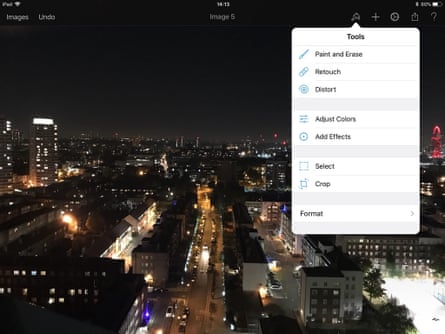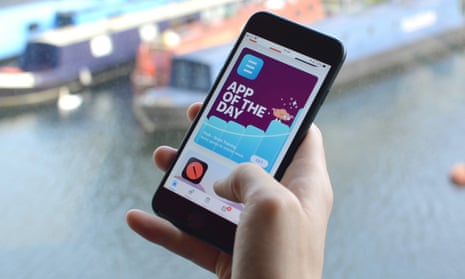“There’s an App for that.” Apple’s slogan, trademarked two years after the App Store was launched in 2008, summed up a period when an unfamiliar icon on a friend’s home screen was a conversation starter, and someone with a good idea working from their bedroom really could do something radically different.
Now Apple wants to bring some of that excitement back to the iPhone of 2017, rebuilding the App Store from the ground up.
Gone is the focus on lists of top sellers, replaced with the new App (and Game) of the Day. The entries are drawn from across the spectrum, from huge developers with large marketing budgets to small utilities made by indie teams. The apps aren’t freebies – Apple expects you to be enthused enough to drop real money on the downloads.
So I did. For a month, I grabbed them all: from those laser targeted at me (productivity app Bear, and password manager 1Password, so good I already own it) to those laser targeted away from me (female fitness app Sweat, pregnancy guide The Wonder Weeks).
I’ve got a fever, and the only cure is more apps
I’ve long pined for the good old days, but at some point along the way, my thirst for novelty died off. I can’t put a precise date on it, but I remember noticing around the end of 2014 that I didn’t regularly use a single app that had been released in the previous two years.
My hope was that living life the Apple way would rekindle some of that excitement. Would I be fitter, happier and more productive? Should I seek professional help about my endless attempts to fix my life with a parade of glowing quadrilaterals?
Maybe. My first surprise was rather more prosaic: it turns out it’s actually really expensive to buy apps every day.
Unlike the free-to-play-dominated mobile games industry, where the many can have a perfectly fun life completely subsidised by the few who will drop £1,000 on power ups and cosmetic items, the app market is more traditional in its attempts to build revenue.
More than a third of the apps promoted in that opening month had a good old-fashioned up-front cost. The days of the 99p app are well and truly numbered, it seems, with prices ranging from £1.99 at the low end to £4.99 at the high. I paid the latter for image editor Pixelmator, which is tremendously good value for what it is, with the app offering many features once exclusive to Adobe’s Photoshop, software that costs almost twice that per month.

Heck, I’ve considered buying Pixelmator multiple times over the years, but never quite been able to get over the initial hurdle of not having a fiver free for that specific purpose, on that specific day. Of course that’s stupid. I have impulse bought almost every bloody seasonal drink Starbucks has ever created to ruin a perfectly good latte, yet I pause at the idea of dropping one and a half eggnog lattes on an app, which has been hailed best-in-class multiple times and will probably last me a good few years.
It’s difficult to persuade people to pay for any app, let alone those that cost more than a couple of pounds, so the market has shifted over the years. The new premium isn’t a high upfront cost – it’s a limited free offering, with either a second in-app purchase or a rolling subscription to unlock the rest.
It’s how a third of the promoted apps work, including brain-training app Lumiosity and body training app Zones. Both offer their core feature free to all users while hiving off the real meat of the app for those paying the subscription.Near the premium end of the spectrum lies Lifesum, a full featured healthy-eating app that asked me to log all my eating habits, plan my meals through it, and pick recipes from its large selection. It was exhausting, and costs £35 a year. There came a time, as I spent another morning pouring milk into a bowl of cereal resting on a scale in an attempt to more accurately work out how much of my recommended daily allowance of fat I was eating, that I genuinely regretted writing this article.
Apps that want to take over your life seem to be a favourite of the App Store team. Besides Lifesum, there’s also Sweat (subscription-only with a one-week free trial and a blistering £90 annual fee), which wants similar control over the eating habits of women, and also their workouts. Kayla Itsines, the Australian fitness guru behind the service, certainly gets results (at least, according to her testimonials), but I’m glad I can escape using it long-term by virtue of my gender.

Unfortunately another pair of apps don’t give me the same excuse. FitMenCook is my kind of fitness app – one entirely focused around eating. But it’s the sort of healthy food that makes conspicuous use of words like “Keto”, and asks me to make a lasagne by blending together an egg white and some ricotta. The problem is I spend a lot more time playing video games than I do moving around. The Nintendo Switch has motion controls, but I don’t think they qualify for what FitMenCook describes as a “Total-Body Pull” workout. It’s a shame, because I quite like the idea of eating four meals a day with a chocolate pumpkin smoothie for elevenses.
Streaks Workout is the one that finally got me. It ticks all my boxes: a rigorous adherence to keeping up patterns of behaviour (I’ve done my 40 daily minutes of language lessons on Duolingo for almost 200 days at this point), a series of workouts that don’t require any fancy gear, or even leaving the house, and a one-off payment of £2.99 for the privilege. I’m far too lazy to be a long term user of an app that wants me to do some sort of workout every single day, though … right? My current streak is two. We’ll see.
For all that I joke about the many fitness apps not really being for me, a lot of the apps of the day genuinely aren’t made for me. Wattpad looks fun if you are a regular reader of a very specific type of fan fiction; Dribbble, a sort of Reddit for designers, is a great place to show off your visual creations; Houzz lets me … shop, apparently, for things for my house, and for people to build the things. I don’t know how many beds you need to buy each month to need an app specifically made for the pleasure, but it’s more than I can afford.
Then there are the kids’ apps. Not being a child – despite what my non-millennial colleagues claim – and nor having one, I can’t really pass judgement here. Yes, Professor Astro Cat’s Solar System is a beautiful hybrid of story-book and educational game, while Lego Life is a hideous quasi social network for anonymously sticking stickers on branded plastic, but kids say the darnedest things, like “father, your mature aesthetic sensibilities mean nothing to me, I want to engage with branded plastic tat on your phone”.

Rules are made to be broken. One of my favourite discoveries was a bizarre app, free to use (but with some in-app purchases), and absolutely not aimed at me in the slightest: Babyname. The app, and there is no other way to put this, is Tinder for baby names. You and your partner both install it, link your accounts, and swipe left or right on a list of names. If you both approve of the same name, it shows up as a match; if you don’t, it doesn’t. It let me secretly express my liking for unusual names such as “Landyn” and “Ricardo” without the risk of being mocked by my other half. And there was always the chance that we might find that secretly, Odo perfectly matches our shared desire for our future progeny to be named after an eighth century French count.
Despite appearances, then, there’s still life in apps. I haven’t even touched on a few of my other favourites from the first month, from detailed Apple Watch data-miner HeartWatch to auto-journaling app Memento, magic photo editor Retouch to password-manager-so-good-I’ve-already-been-using it-for-five-years 1Password. They’re not all new, obviously, but there are enough for me to realise I’ve been missing out.
My stagnant habits meant I wasn’t getting the most out of my smartphone. For want of the odd £2 here and there, a device that costs many hundreds of times that was being wasted, left to to be a machine for Twitter, Spotify and emails.
And it looks like I’m not the only one who’s found that. According to stats from analytics firm Apptopia, being featured on App of the Day boosted downloads by an astonishing 1,747%.
That’s a lot of people who, it turns out, do have a vague desire to get more out of their phone, but get overwhelmed by the sheer number of apps available. I’ll bet it’s you, too. If so, why not give the app life a try? All you have to lose is your storage space.
